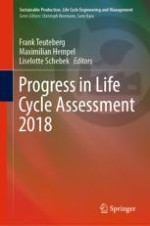2019 | Buch
Progress in Life Cycle Assessment 2018
herausgegeben von: Prof. Dr. Frank Teuteberg, Dr. Maximilian Hempel, Prof. Dr. Liselotte Schebek
Verlag: Springer International Publishing
Buchreihe : Sustainable Production, Life Cycle Engineering and Management
